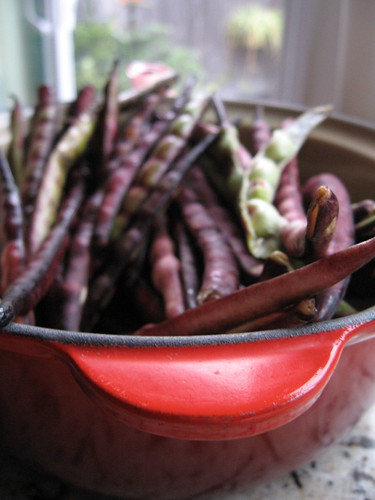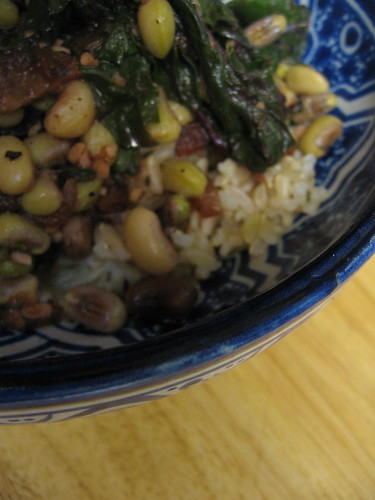Unfortunately for you and me, even the warmer climes are reaching the sad end of fresh black-eyed peas. After six weeks of walking past heaping boxes of purple-green pods, I took the plunge in time for only two meals; at the market this Saturday, only one vendor had one sad pile of beans left.

Even when I've bought canned beans for the sake of simplicity, I've long been in the dried-beans-are-better-than-canned camp, but I have had few opportunities to try fresh shelling beans. The spring is filled with hours of thumbnail-splitting fava bean preparation, but I've yet to see the beloved fresh limas, borlotti, or cranberry beans of which I've heard so many tales. If they're anything like black-eyed peas, though, I'll be on the hunt.
This is a virtuous dish despite the use of bacon. After lardons of bacon are sautéed until crisp, sweet onions are caramelized in some of the rendered bacon fat. The greens are added with some stock, garlic, and liberal amounts of pepper, then gently mixed with the tender beans and the bacon. I served it over brown rice, but it would be equally delicious with pasta, or perhaps made with a little bit more broth and poured over a piece of crusty, toasted bread.

If you can't find fresh black-eyed peas, this dish would also be great with dried beans—I've included notes for adjusted soaking/cooking times in the recipe below.
Fresh Black-Eyed Peas with Swiss Chard
This dish can easily be made kosher/vegan by omitting the bacon and replacing the bacon grease with 2 tablespoons of good olive oil. If you would like a smoky flavor that the bacon brings, try sprinkling the dish with a bit of smoked sea salt before serving.
This dish doubles easily and reheats well, so make lots while fresh beans are available!
¾ to 1 pound (unshelled) fresh black-eyed peas (for 1 ½-2 cups shelled beans), or 1 cup dried
2 slices bacon
½ large sweet onion, thinly sliced
2 cloves garlic, peeled and chopped
½ cup chicken or vegetable stock
2-3 sprigs fresh thyme (optional)
1 medium bunch Swiss chard, center ribs removed (about 8 oz net), chopped or roughly torn up
salt and coarsely ground black pepper
1 teaspoon apple cider vinegar
Shell the fresh beans into a medium saucepan. Rinse well and cover with cold water at least one inch above the beans. Bring to a boil over medium-high heat; reduce heat, cover, and simmer until just tender, 15-25 minutes (for best results, do not salt). Rinse with cold water, drain, and set aside.
Meanwhile, cut the bacon crosswise about ½ inch (1 cm) thick and cook until golden and crisp over medium-high heat. Transfer the bacon to a paper towel to drain. Pour off roughly half the grease, leaving about 2 tablespoons in the pan. Add the onion, reduce the heat to medium-low, and cook, stirring regularly, until caramelized to your taste, about 20 minutes.
Add the garlic and cook, stirring until fragrant. Add the stock and thyme; deglaze the pan, then increase heat to medium. Add the chard a handful at a time, stirring gently until wilted. When all the chard is added, partially cover and simmer until tender, about 10 minutes.
Add the bacon, drained beans, and cider vinegar; taste and add salt as needed and liberal amounts of cracked pepper.
Serve over rice, toss with pasta or add additional stock to make a hearty stew.
NOTE: If you are using dried black-eyed peas, you can pre-soak or not.
To pre-soak: rinse, then cover with cold water in a medium saucepan. Bring to a boil, then turn off the heat, cover, and set aside for one hour. Drain, cover again with cold water and simmer until tender, about 30 minutes. (Pre-soaking will take longer; some people think it makes the beans easier to digest, but it is not necessary with black-eyed peas)
To cook directly: rince, cover with cold water in a medium saucepan. Bring to a boil, then reduce heat. Cover and simmer until tender, about 45-60 minutes.
Serves 2-3; doubles easily to serve 3-6.

hey, great pictures! I'm still hoping that the weather around here will continue to produce some kale and chard. we shall see.
ReplyDelete